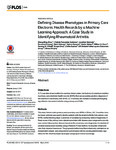Defining Disease Phenotypes in Primary Care Electronic Health Records by a Machine Learning Approach: A Case Study in Identifying Rheumatoid Arthritis
| dc.contributor.author | Zhou, Shang-Ming | |
| dc.contributor.author | Fernandez-Gutierrez, F | |
| dc.contributor.author | Kennedy, J | |
| dc.contributor.author | Cooksey, R | |
| dc.contributor.author | Atkinson, M | |
| dc.contributor.author | Denaxas, S | |
| dc.contributor.author | Siebert, S | |
| dc.contributor.author | Dixon, WG | |
| dc.contributor.author | O’Neill, TW | |
| dc.contributor.author | Choy, E | |
| dc.contributor.author | Sudlow, C | |
| dc.contributor.author | Brophy, S | |
| dc.date.accessioned | 2021-02-04T22:23:05Z | |
| dc.date.available | 2021-02-04T22:23:05Z | |
| dc.date.issued | 2016-05-02 | |
| dc.identifier.issn | 1932-6203 | |
| dc.identifier.issn | 1932-6203 | |
| dc.identifier.other | ARTN e0154515 | |
| dc.identifier.uri | http://hdl.handle.net/10026.1/16855 | |
| dc.description.abstract |
OBJECTIVES: 1) To use data-driven method to examine clinical codes (risk factors) of a medical condition in primary care electronic health records (EHRs) that can accurately predict a diagnosis of the condition in secondary care EHRs. 2) To develop and validate a disease phenotyping algorithm for rheumatoid arthritis using primary care EHRs. METHODS: This study linked routine primary and secondary care EHRs in Wales, UK. A machine learning based scheme was used to identify patients with rheumatoid arthritis from primary care EHRs via the following steps: i) selection of variables by comparing relative frequencies of Read codes in the primary care dataset associated with disease case compared to non-disease control (disease/non-disease based on the secondary care diagnosis); ii) reduction of predictors/associated variables using a Random Forest method, iii) induction of decision rules from decision tree model. The proposed method was then extensively validated on an independent dataset, and compared for performance with two existing deterministic algorithms for RA which had been developed using expert clinical knowledge. RESULTS: Primary care EHRs were available for 2,238,360 patients over the age of 16 and of these 20,667 were also linked in the secondary care rheumatology clinical system. In the linked dataset, 900 predictors (out of a total of 43,100 variables) in the primary care record were discovered more frequently in those with versus those without RA. These variables were reduced to 37 groups of related clinical codes, which were used to develop a decision tree model. The final algorithm identified 8 predictors related to diagnostic codes for RA, medication codes, such as those for disease modifying anti-rheumatic drugs, and absence of alternative diagnoses such as psoriatic arthritis. The proposed data-driven method performed as well as the expert clinical knowledge based methods. CONCLUSION: Data-driven scheme, such as ensemble machine learning methods, has the potential of identifying the most informative predictors in a cost-effective and rapid way to accurately and reliably classify rheumatoid arthritis or other complex medical conditions in primary care EHRs. | |
| dc.format.extent | e0154515-e0154515 | |
| dc.format.medium | Electronic-eCollection | |
| dc.language | en | |
| dc.language.iso | eng | |
| dc.publisher | Public Library of Science (PLoS) | |
| dc.rights | Attribution-NonCommercial 4.0 International | |
| dc.rights | Attribution-NonCommercial 4.0 International | |
| dc.rights | Attribution-NonCommercial 4.0 International | |
| dc.rights | Attribution-NonCommercial 4.0 International | |
| dc.rights.uri | http://creativecommons.org/licenses/by-nc/4.0/ | |
| dc.rights.uri | http://creativecommons.org/licenses/by-nc/4.0/ | |
| dc.rights.uri | http://creativecommons.org/licenses/by-nc/4.0/ | |
| dc.rights.uri | http://creativecommons.org/licenses/by-nc/4.0/ | |
| dc.subject | Algorithms | |
| dc.subject | Antirheumatic Agents | |
| dc.subject | Arthritis, Rheumatoid | |
| dc.subject | Electronic Health Records | |
| dc.subject | Humans | |
| dc.subject | Machine Learning | |
| dc.subject | Primary Health Care | |
| dc.title | Defining Disease Phenotypes in Primary Care Electronic Health Records by a Machine Learning Approach: A Case Study in Identifying Rheumatoid Arthritis | |
| dc.type | journal-article | |
| dc.type | Journal Article | |
| dc.type | Research Support, Non-U.S. Gov't | |
| plymouth.author-url | https://www.webofscience.com/api/gateway?GWVersion=2&SrcApp=PARTNER_APP&SrcAuth=LinksAMR&KeyUT=WOS:000375674800025&DestLinkType=FullRecord&DestApp=ALL_WOS&UsrCustomerID=11bb513d99f797142bcfeffcc58ea008 | |
| plymouth.issue | 5 | |
| plymouth.volume | 11 | |
| plymouth.publication-status | Published online | |
| plymouth.journal | PLOS ONE | |
| dc.identifier.doi | 10.1371/journal.pone.0154515 | |
| plymouth.organisational-group | /Plymouth | |
| plymouth.organisational-group | /Plymouth/Faculty of Health | |
| plymouth.organisational-group | /Plymouth/Faculty of Health/School of Nursing and Midwifery | |
| plymouth.organisational-group | /Plymouth/REF 2021 Researchers by UoA | |
| plymouth.organisational-group | /Plymouth/REF 2021 Researchers by UoA/UoA03 Allied Health Professions, Dentistry, Nursing and Pharmacy | |
| plymouth.organisational-group | /Plymouth/Users by role | |
| plymouth.organisational-group | /Plymouth/Users by role/Academics | |
| dc.publisher.place | United States | |
| dcterms.dateAccepted | 2016-04-14 | |
| dc.identifier.eissn | 1932-6203 | |
| dc.rights.embargoperiod | Not known | |
| rioxxterms.funder | Medical Research Council | |
| rioxxterms.identifier.project | DECIPHer: Centre for the Development and Evaluation of Complex Interventions for Public Health Improvement | |
| rioxxterms.versionofrecord | 10.1371/journal.pone.0154515 | |
| rioxxterms.licenseref.uri | http://creativecommons.org/licenses/by-nc/4.0/ | |
| rioxxterms.licenseref.startdate | 2016 | |
| rioxxterms.type | Journal Article/Review | |
| plymouth.funder | DECIPHer: Centre for the Development and Evaluation of Complex Interventions for Public Health Improvement::Medical Research Council |



